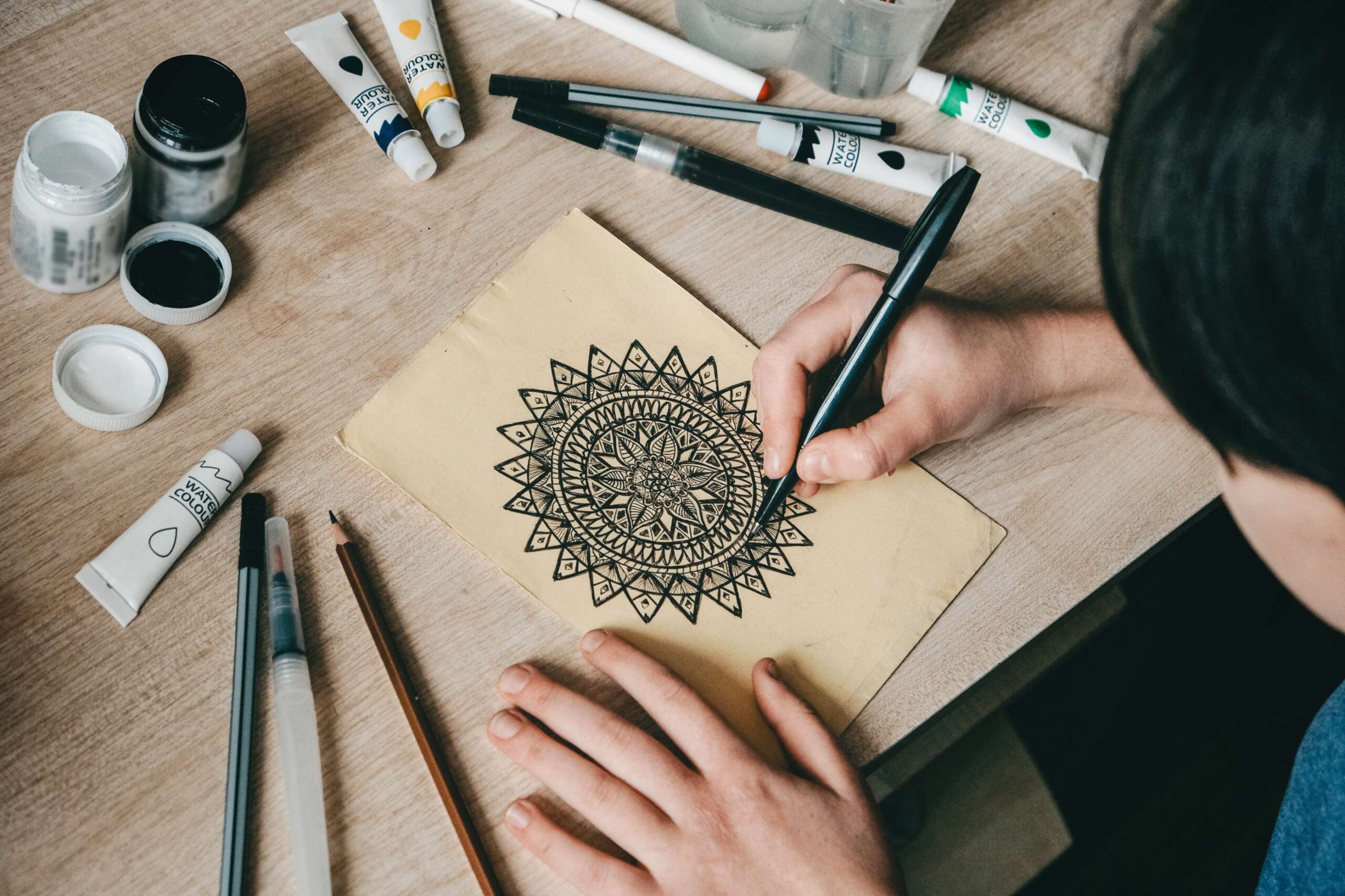Art and Stillness: A Natural Connection
After decades as an art educator and therapist, I’ve come to believe that some of the most powerful forms of healing don’t require words at all. They require presence. They require space. And sometimes, they simply require a brush and a quiet moment.
Art and mindfulness go hand in hand. Both allow us to slow down, breathe, and check in with ourselves. Both invite us to listen—to our bodies, our thoughts, and our inner world. When combined, art and mindfulness become a powerful tool for self-care and mental wellness, accessible to anyone, regardless of skill level or background.
In my personal life, I practice both regularly. Meditation, journaling, gardening, and creating art are cornerstones of how I care for myself. In my professional life, I bring those same practices into the classroom and therapy room, helping others discover how creativity and stillness can lead to healing and growth.
What Is Mindfulness, Really?
Mindfulness isn’t a trendy buzzword—it’s an ancient practice rooted in awareness and compassion. At its core, mindfulness means paying attention to the present moment without judgment. It’s noticing your thoughts, emotions, and surroundings with openness, rather than reacting automatically.
For many people, mindfulness starts with something simple: focusing on your breath, noticing sensations in the body, or observing the sounds around you. Over time, this gentle attention becomes a way to stay grounded, even during stress or emotional difficulty.
When we bring mindfulness into the creative process, we’re not trying to make “perfect” art. We’re exploring the act of making with curiosity and presence. Whether we’re painting, drawing, sculpting, or just doodling, the goal is to stay connected to ourselves and the moment we’re in.
Art as a Mindful Practice
One of the things I love most about art is that it naturally encourages mindfulness. Have you ever noticed how time seems to disappear when you’re really focused on a project? That’s what psychologists call “flow”—a deeply mindful state where we’re fully absorbed in what we’re doing.
Art helps us tune out distractions and focus our energy. When I paint or draw, I become aware of my breath, my movements, the texture of the materials. I’m not worrying about the past or the future. I’m simply here.
In my teaching and therapy work, I often guide people through simple mindfulness-based art exercises. These might include slow, repetitive mark-making, intuitive painting with eyes closed, or drawing to the rhythm of your breath. The goal isn’t to make something “good.” The goal is to be present, to explore, and to express without pressure.
Making Space for Self-Care
In our fast-paced, overstimulated world, it’s easy to lose touch with ourselves. Many people push through stress, numb their emotions, or feel disconnected from their bodies. That’s why self-care isn’t a luxury—it’s a necessity.
Art gives us a safe, gentle way to return to ourselves. When we create with mindfulness, we give ourselves permission to slow down, feel our feelings, and reconnect. We begin to notice the subtle shifts in our mood, the messages our bodies are sending, and the thoughts that need attention.
One of my favorite self-care practices is a “visual journal.” Each day, I spend a few quiet minutes making a small sketch or collage that reflects how I’m feeling. Sometimes it’s messy. Sometimes it’s joyful. Always, it’s honest. This daily ritual has become a touchstone in my life, helping me stay grounded and centered no matter what’s happening around me.
Bringing Mindful Art into the Classroom
In my role as Art Educator and Department Head, I’ve woven mindfulness into the structure of our curriculum and classroom culture. We begin many classes with short breathing exercises or quiet drawing time. We talk about the emotions that surface during creative work. We normalize mistakes and celebrate process over product.
Students often tell me that art class is the only time during their day when they feel calm. That means something. It means that these mindful practices aren’t just helpful—they’re essential.
In addition to formal instruction, I also use therapeutic art practices with students dealing with anxiety, grief, or other emotional challenges. Even five minutes of mindful coloring or guided drawing can help a student regain their focus and feel more in control.
Mindfulness Is for Everyone
The beautiful thing about mindful art is that it’s for everyone. You don’t have to be an artist. You don’t have to have a studio or expensive materials. All you need is a piece of paper, something to make marks with, and a willingness to slow down and pay attention.
Start with something small. Try drawing a circle while breathing slowly. Paint to music and see what comes up. Doodle with your non-dominant hand. Let go of judgment and just explore.
You might be surprised by what emerges—emotion, insight, even a sense of peace.
Final Thoughts: Healing Through Creativity
I’ve always believed that art is more than a subject—it’s a way of life. It’s a way of healing, expressing, and understanding ourselves more deeply. When we pair that creativity with mindfulness, we tap into something profound: the ability to soothe our nervous systems, process our emotions, and nurture our spirit.
Whether I’m working with students, clients, or simply taking time for myself, I continue to return to these gentle practices—brushstrokes of the soul that guide us back to wholeness.
In a world that asks us to move quickly and carry so much, art and mindfulness offer a quiet, steady voice that says: Come home to yourself.
